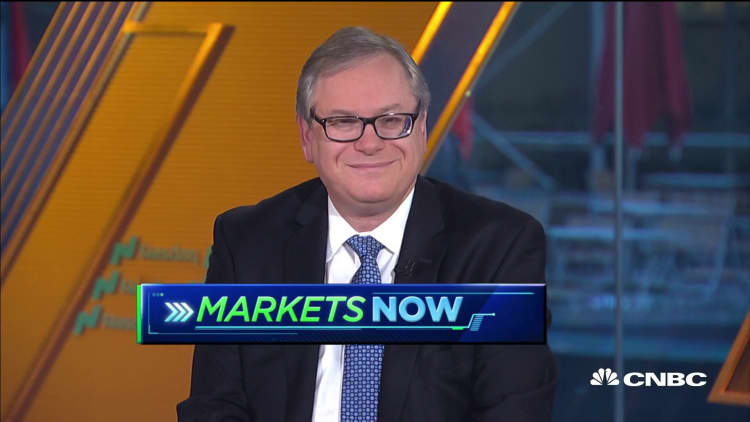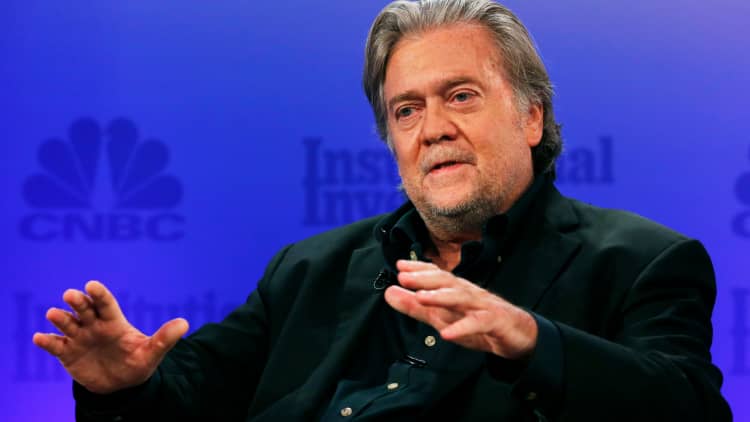Consumer and industrial activity in both the U.S. and China slowed in April, even before the world's two biggest economies entered the latest phase of an escalating trade war that could take a bite out of global growth.
"The real message today is that both the economic data from the U.S. and China have disappointed. They're like two boys in the sandbox that are spitting on each other, and it could get a lot worse," said Marc Chandler, global market strategist at Bannockburn Global Forex.
The latest round of tariffs announced by President Donald Trump and China President Xi Jinping raised the stakes and potential economic hit on both economies. Trump boosted the tariffs on $200 billion in goods to 25% from 10%, while Xi upped the tariffs on $60 billion in goods.

Economists see about a 0.4 to 0.5% hit on China's GDP and about a 0.1% hit to the U.S. from the higher tariffs. Strategas Research estimates the higher tariffs would cut into U.S. growth by 0.1% for every two months the raised tariffs are in place, or 0.5% a year.
Trump also threatened 25% tariffs on another $325 billion in Chinese goods, which economists say could hit Chinese sales and send prices higher for U.S. consumers. The impact of those tariffs would be even greater on GDP.
China's retail sales rose 7.2% in April, the slowest pace in 16 years and less than March's 8.7% and forecasts of 8.6%. China's April industrial production rose 5.4%, less than the 6.5% expected or the 8.5% gain in March.
"This is the first bit of cleaner data we're getting, and it paints a much less rosy picture of the economy than a lot of people thought was happening," said Gareth Leather of Capital Economics. Leather said seasonal factors could have masked weakness in March data, which showed some improvement and had appeared to be signs of green shoots and recovery. "This really quashes those hopes for the time being."
U.S. retail sales slid 0.2% in April, down from the surprise jump of 1.7% gain in March. Car sales fell 1.1% last month, while sales at electronics and appliance stores lost 1.3%. Economists had expected a 0.2% gain in the monthly sales data, which is important since it reflects the health of the consumer, about 70% of the U.S. economy.
U.S. industrial production, reflecting total production at factories, utilities and mines, fell 0.5% after a 0.2% gain in March. Manufacturing output dropped 0.5%, led by a 2.6% decline in motor vehicles and parts, the third decrease in four months and the latest manufacturing report to show softness.
Tariff impact
"Autos had a weird swing, as a result of excess inventories," said Michelle Meyer, chief U.S. economist at Bank of America Merrill Lynch. "I'll be paying pretty close attention to manufacturing data, the survey datas, the confidence measures. It's going to be very important to watch how the economy is going to fare around the escalation. Manufacturing has weakened already." She said that manufacturing has been falling off since peaking last summer.
She said the trade wars have had an impact on the manufacturing sector, with about 59% of companies in the ISM semi-annual survey saying that the tariffs have led to an increase in the price of goods produced.
Meyer described the weaker April retail sales data as "noise," but said it bears watching if the tariffs go into place on the $325 billion in goods since they would directly affect many consumer products. Manufacturers have been reporting impacts from tariffs, with 59% saying production costs went up as a result.
Markets responded to the news from both countries by ramping up expectations for central bank and other policy easing. U.S. fed funds futures signaled expectations for more than one quarter-point rate cut this year, while China's stock markets rallied on expectations of more fiscal and monetary stimulus.
"Both economies softened before the tariff truce ended, but what's interesting is still we're not talking about recessionary levels. If China grows less than 6%, that's a big deal," said Chandler. He said U.S. growth currently looks to be averaging 2.4% in the first half.

"I think the chances the Fed will have to cut rates before the end of the year have clearly increased, given the trade war scenario. It's still not my baseline. I think the Fed has to be careful in responding to the current trade tensions. It's not obvious how persistent it will be, and how it will play out in the real economy," Meyer said.
Trump has repeatedly called on the Fed to cut interest rates, including on Tuesday when he said China will probably cut interest rates, and if the U.S. did so as well it would be "game over."
Leather said if Trump goes through with the next round of tariffs, they may end up being more harmful to U.S. consumers than to China, since many of the goods cannot be sourced elsewhere. The first round of tariffs did not do all that much harm to China, and its economy has been in decline for years, he said.
"It will impact China" if the tariffs on $325 billion in goods are implemented, Leather said. "But not as much as people think. The impact on the U.S. will be more." He said China's issues are lingering.
"If you look at Q1, China's exports to the U.S. underperformed the rest of the world by 13%, and they normally pretty much match. They go in lockstep. There does seem to be some impact there. But if you look at China's exports to the U.S. as a share of GDP, it's about 3%. Thirteen percent of 3% is very small. Some of the slowdown in China is related to trade, but a very small percent," he said.


